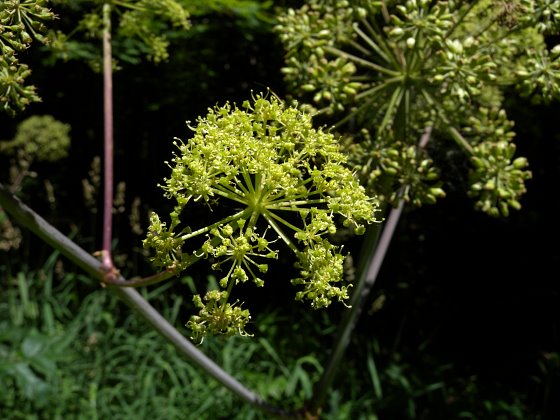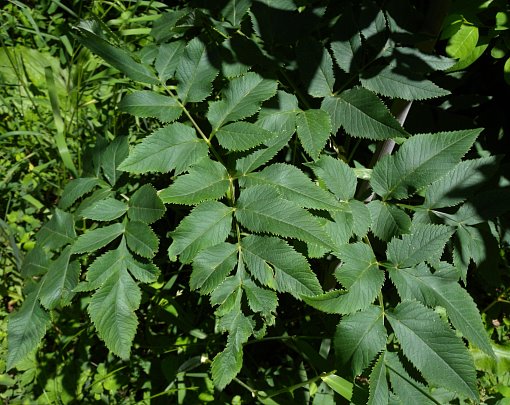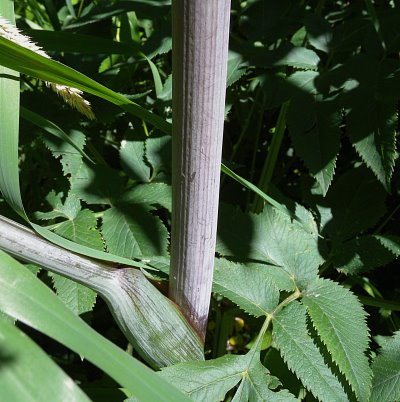
The upper stems terminate in one or more compound umbels of flowers spanning 3-9" across; they are globoid in shape. Sometimes the peduncle of a compound umbel will branch and terminate in another compound umbel. Each compound umbel has 15-40 rays (floral branches) that terminate in small umbellets. Each umbellet has numerous greenish white to pale yellow flowers on pedicels about ½" in length. Each flower is up to ¼" across, consisting of 5 petals with incurved tips, a light green calyx without significant lobes, 5 stamens, and a pistil with a divided style. The blooming period occurs from late spring to early summer and lasts about 3 weeks. Afterwards, the flowers are replaced by dry seed-like fruits (consisting of double achenes). The fruits are 5-8 mm. in length, oblongoid-ovoid in shape, and slightly flattened; each side of the fruit has 3 longitudinal ridges. Immature fruits are greenish yellow, turning brown at maturity. Each achene has a pair of lateral wings along its main body; it is convex and ridged on one side, while the other side is flat. The root system consists of a short stout taproot.
Cultivation: The preference is full or partial sun, consistently wet to moist conditions, and loamy or sandy soil with decaying organic matter. Soil pH should be mildly acidic to alkaline. Standing water is well-tolerated. Individual plants can vary considerably in size depending on environmental conditions.

Range & Habitat: The native Great Angelica is occasional in northern Illinois, while in the rest of the state it is uncommon or absent (see Distribution Map). Habitats include openings in bottomland woodlands, swamps, soggy thickets, edges of woodlands adjoining wetlands, marshes, fens, and seeps, including the lower slopes of hillside seeps. This robust wildflower is typically found in calcareous habitats with a stable supply of moisture.
Faunal Associations: The flowers attract Syrphid flies, bee flies, Andrenid bees, and other small bees. These visitors are attracted primarily to the nectar of the flowers. A relatively small number of insects are known to feed on Great Angelica. These species include the aphids Aphis thaspii and Cavariella konoi, caterpillars of Papaipema birdi (Umbellifer Borer Moth) and Papaipema harrisii (Cow Parsnip Borer Moth), and caterpillars of the butterfly Papilio polyxenes asterius (Black Swallowtail).

Photographic Location: A woodland border near a fen at the Indiana Dunes National Lakeshore in NW Indiana.
Comments: Great Angelica can be distinguished from similar species in the Carrot family by its large size, hollow purplish stems, and spherical compound umbels. Sometimes an aromatic Eurasia species, Angelica archangelica (Garden Angelica), is cultivated in gardens. It differs from Great Angelica by its biennial habit and greenish stems. So far, there are no records of Garden Angelica naturalizing in Illinois. A native perennial species, Angelica venenosa (Wood Angelica), is found in southern Illinois, where it occurs in dry rocky habitats. Wood Angelica has more narrow sheaths at the bases of its petioles than Great Angelica, and their are fine hairs on its fruits. Another common name of Angelica atropurpurea is Purple-Stemmed Angelica.